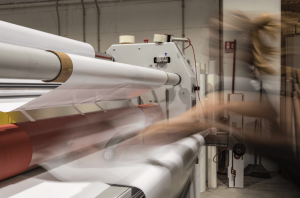A fantastic advantage with modern sheet-fed laminating services is they can produce a run of products very quickly. Whether it is covers, cards, packaging, or other applications, you can get a batch in a very short space of time. However, you need to ensure you choose the right equipment. Specifically, you need to think carefully about web separation. It can have an impact on production speed and the finish.
What is web separation?
 The crucial thing to keep in mind is the laminating is continuous. Therefore, the film will connect each product. Later in the process, web separation is necessary. It separates the products, resulting in a neat stack.
The crucial thing to keep in mind is the laminating is continuous. Therefore, the film will connect each product. Later in the process, web separation is necessary. It separates the products, resulting in a neat stack.
There are a number of different ways to separate the web in the laminating process. It all comes down to the type of tooling. You must think carefully about this because different tools work with various materials and web thicknesses. As a result, there will be situations where some methods are not suitable and others will provide better finishes.
Single sided web separation
Some laminating services only apply film to a single side. Therefore, there is a bit more flexibility when it comes to separating the web. The tooling will only need to get through a single layer of film and potentially the substrate.
Bursting
One of the most common methods here is bursting separation. It is unique because it doesn’t require the use of a knife or blade. Instead, it creates tiny perforations in the film to weaken it. Then, as the product moves through the laminator, a skew roller angles it slightly before burst rollers pull it cleanly to separate the products.
There are some advantages with bursting separation. For example, it is cost effective and allows high speed production. However, there are some drawbacks too. Most crucially, bursting is not viable for tougher films.
Flying knife
An alternative method of web separation is to use a blade to physically cut the laminate. There are a number of options here because the blades can be different shapes. Generally, you’ll have a choice of L, V, or straight knife.
Flying knife separation is interesting because it can work with a wider range of films, including tougher and thicker laminates. But, there are some cons. Notably, it can leave behind a “film flag”. Production time is slower too because the sheet has to stop every time there needs to be a cut.
Hot knife
The difference here is the blade heats up to an incredibly high temperature, sometimes as high as 400 degrees Celsius. Interestingly, the knife doesn’t cut the film; the heat actually vaporises it. That results in a really clean edge.
Hot knife separation works for all kinds of thermal laminates. However, you can’t use it for vinyl laminate or if the substrate is plastic. There are some great benefits, including the speed of production. The cost is a drawback though.
Double sided web separation
Some laminating services apply film to both sides of products, ensuring encapsulation. It can provide benefits, but it does make separation more challenging. The crucial thing to keep in mind here is the tooling will need to get through two layers of film, so twice the thickness. In some cases it will need to cut through the substrate too.
Guillotine
The most common web separation method here works exactly like the ancient execution device. It has a straight knife or slightly angled bar blade that drops from above. A second blade underneath, known as a bed, means the guillotine works like a giant pair of scissors, cutting both sides simultaneously.
This method of separation is popular for double sided laminating because it is economical. It offers some versatility too, including the ability to create a sealed edge. However, set up problems can cause imprecision with cuts.
Flying rotary knife
The alternative for double sided web separation is to use a spinning metal blade. The laminate will sit on a bed blade. The rotary knife will come down and spin across, cleaning severing the web.
Easily the best advantage here is the rotary knives can go either direction. They also offer flexibility with the cutting settings. As a result, this method can also offer sealed edge encapsulation. The only drawback is traditionally the production speed has been slower.
Talk to us about laminating services
Lamination is something we truly excel at. We can apply different films to a massive array of substrates. Most importantly, we’ll ensure we choose the right equipment for each project. So, contact us if you want to discuss anything.
